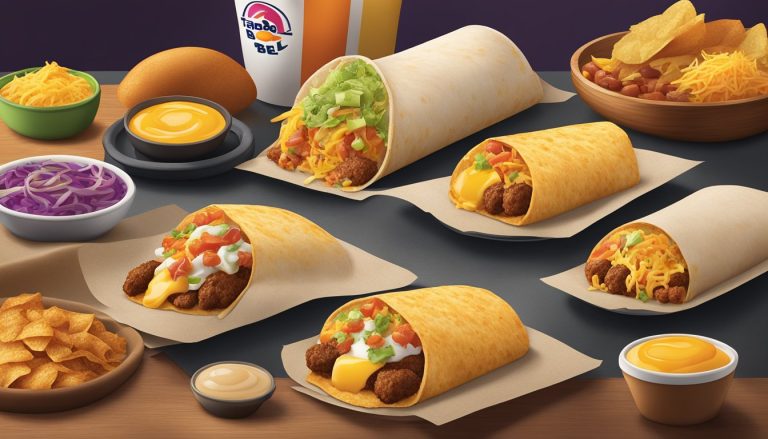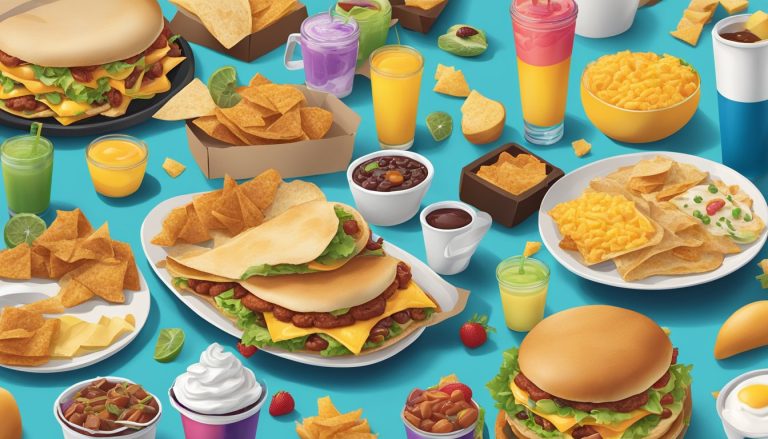Taco Bell’s breakfast menu has captured the hearts and taste buds of many fast food enthusiasts. The chain’s innovative approach to morning meals offers a unique twist on traditional breakfast fare, appealing to those seeking bold flavors to start their day. Cravings for Taco Bell’s breakfast items often stem from a combination of convenience, novelty, and the satisfaction of indulging in comfort food.
The psychology behind these cravings is complex. Fast food companies like Taco Bell have mastered the art of creating products that hit multiple pleasure centers in the brain. Their breakfast offerings combine savory, sweet, and umami flavors, triggering a dopamine release that reinforces the desire for these foods. Additionally, the convenience factor plays a significant role, as Taco Bell provides a quick and easy solution for busy morning routines.
Taco Bell’s breakfast menu caters to those who crave something different from traditional breakfast options. By offering items like breakfast burritos and Crunchwraps, the chain taps into the growing trend of all-day breakfast and the blurring lines between meal categories. This approach appeals to consumers’ desire for flexibility and excitement in their dining choices, contributing to the strong cravings some experience for Taco Bell’s morning offerings.
Understanding the Allure of Taco Bell’s Breakfast

Taco Bell’s breakfast offerings have captivated consumers through a combination of psychological factors, strategic marketing, and industry positioning. The fast food chain has tapped into core human motivations and preferences to create a compelling breakfast menu.
Psychological Drivers of Fast Food Cravings
Fast food cravings often stem from a complex interplay of psychological factors. Emotional exhaustion can lead individuals to seek comfort in familiar, convenient meals. Taco Bell’s breakfast items provide a quick dopamine boost, satisfying the need for immediate gratification.
Personality traits also influence breakfast choices. Those high in openness to experience may be drawn to Taco Bell’s unique breakfast offerings. Conscientious individuals might appreciate the efficiency of a fast food breakfast.
Taco Bell’s breakfast menu appeals to various psychological needs. It offers novelty for those seeking excitement and routine for those craving stability. The combination of flavors and textures in items like breakfast burritos can trigger reward centers in the brain.
Impact of Marketing Campaigns on Breakfast Choices
Taco Bell’s marketing campaigns have played a crucial role in shaping consumer perceptions of their breakfast menu. The company has utilized humor and relatability to create memorable advertisements that resonate with their target audience.
By emphasizing innovation and uniqueness, Taco Bell has positioned its breakfast as an exciting alternative to traditional options. Their campaigns often highlight the portability and convenience of their breakfast items, appealing to busy consumers.
Social media marketing has been particularly effective in generating buzz around new breakfast offerings. Taco Bell leverages user-generated content and influencer partnerships to create a sense of community around their breakfast menu.
Taco Bell’s Position in the QSR Industry
In the competitive Quick Service Restaurant (QSR) industry, Taco Bell has carved out a unique niche with its breakfast offerings. The company’s willingness to experiment with unconventional breakfast items sets it apart from more traditional fast food chains.
Taco Bell’s breakfast menu aligns with broader industry trends towards all-day breakfast options. This flexibility appeals to consumers with non-traditional schedules or those who enjoy breakfast foods at various times of day.
The company’s focus on value pricing for breakfast items has helped attract price-sensitive consumers. By offering affordable options, Taco Bell has positioned itself as an accessible choice for a wide range of breakfast customers.
Decoding the Breakfast Menu at Taco Bell
Taco Bell’s breakfast menu offers a unique blend of traditional morning fare with a Mexican-inspired twist. The offerings aim to satisfy cravings while providing sustenance to start the day.
Assessing the Popularity of Breakfast Items
The Breakfast Crunchwrap stands out as a fan favorite, combining scrambled eggs, bacon or sausage, cheese, and hash browns in a grilled tortilla. Breakfast Burritos also rank high, appealing to those seeking a portable meal.
Quesadillas and tacos featuring eggs and various proteins cater to customers looking for familiar Taco Bell flavors in breakfast form. The Cinnabon Delights, sweet dough balls filled with icing, offer a dessert-like option that has gained a loyal following.
Menu popularity often fluctuates, with Taco Bell occasionally introducing limited-time items to gauge customer interest and keep the selection fresh.
Nutritional Analysis of Breakfast Offerings
Taco Bell’s breakfast items vary widely in nutritional content:
- Breakfast Crunchwrap: ~670 calories, 41g fat, 16g protein
- Grande Toasted Breakfast Burrito: ~560 calories, 30g fat, 20g protein
- Hash Brown: ~160 calories, 11g fat, 1g protein
Many items are high in calories and fat, reflecting their indulgent nature. Sodium levels tend to be elevated, a common trait in fast food. Some offerings provide a decent amount of protein, which can help with satiety.
Fiber content is generally low, except in bean-containing items. Most breakfast choices are significant sources of carbohydrates, primarily from tortillas and potatoes.
Balancing Flavor and Health
Taco Bell offers some lighter options for health-conscious customers. The Cheesy Toasted Breakfast Burrito, at around 340 calories, provides a more moderate choice. Customization allows for potential calorie reduction by omitting certain ingredients.
For those seeking to boost nutritional value, adding black beans can increase fiber and protein content. Opting for “Fresco” style replaces cheese, sour cream, and sauce with pico de gallo, reducing fat and calories.
While Taco Bell’s breakfast menu prioritizes bold flavors and indulgence, mindful choices can lead to a more balanced meal. Pairing menu items with sides like fruit or yogurt from home can enhance nutritional value.
Psychological Theories Behind Food Selection

Psychological theories offer insights into why people choose certain foods over others. These theories explore how internal motivations and personality traits influence eating habits and food preferences.
Self-Determination Theory and Food Choices
Self-Determination Theory (SDT) proposes that people have three basic psychological needs: autonomy, competence, and relatedness. When applied to food selection, SDT suggests that individuals are more likely to make healthier choices when they feel in control of their decisions.
Autonomous motivation, where people choose foods based on personal values and interests, tends to lead to more nutritious eating habits. Conversely, controlled motivation, driven by external pressures or guilt, often results in less healthy food choices.
SDT also emphasizes the importance of feeling competent in making food decisions. People who believe they have the knowledge and skills to prepare healthy meals are more likely to do so consistently.
Link between Personality Traits and Eating Habits
The Big Five personality dimensions – Openness, Conscientiousness, Extraversion, Agreeableness, and Neuroticism – have been linked to different eating patterns and food preferences.
Conscientiousness is associated with healthier eating habits. Highly conscientious individuals tend to plan meals, stick to dietary guidelines, and resist impulsive food choices.
Agreeableness has been linked to a preference for sweet and savory foods. Agreeable people may be more susceptible to social influence when making food choices, potentially leading to both healthy and unhealthy eating patterns depending on their social environment.
Openness to experience often correlates with a willingness to try new foods and diverse cuisines. This trait can lead to a more varied diet but doesn’t necessarily guarantee healthier choices.
Consumer Behavior and Taco Bell’s Breakfast
Taco Bell’s breakfast offerings tap into key consumer behavior trends. Lifestyle factors and the demand for convenience shape breakfast choices in the quick-service restaurant industry.
Influence of Lifestyle on Breakfast Decisions
Modern lifestyles impact breakfast habits significantly. Many consumers prioritize sleep over elaborate morning meals, creating an opportunity for Taco Bell’s grab-and-go options.
The rise of non-traditional work schedules has blurred traditional meal times. This shift benefits Taco Bell’s extended breakfast hours, catering to late risers and night shift workers.
Health-conscious consumers seek nutritious breakfast options. Taco Bell has responded by offering items like breakfast burritos with egg whites and reduced-fat options.
The Role of Convenience and Quick Service
Speed is crucial for morning diners. Taco Bell’s drive-thru service and efficient food preparation meet the needs of time-pressed customers.
The familiarity of Taco Bell’s menu appeals to those seeking comfort food for breakfast. Items like breakfast quesadillas provide a satisfying start to the day.
Affordability plays a key role in breakfast decisions. Taco Bell’s competitive pricing strategy attracts budget-conscious consumers looking for value in their morning meal.
The Role of Nutrition in Consumer Choice

Nutritional factors play a significant part in shaping consumer decisions at fast food restaurants like Taco Bell. While taste often drives choices, health-conscious consumers also consider the nutritional value of menu items.
Evaluating Taco Bell’s Healthier Alternatives
Taco Bell offers several lower-calorie options for health-conscious customers. The Fresco menu features items made with fresh pico de gallo instead of cheese and sauces. These choices can reduce calorie and fat content while still providing flavor.
Some healthier Taco Bell breakfast options include:
- Egg and cheese soft taco (170 calories, 9g protein)
- Mini skillet bowl (180 calories, 5g protein)
- Breakfast soft taco with egg and cheese (230 calories, 11g protein)
These items provide protein to help start the day, while keeping calories in check. Opting for black beans instead of refried beans can boost fiber content.
Understanding Nutrient Content in Fast Food
Fast food often contains high levels of sodium, saturated fat, and added sugars. At Taco Bell, many menu items exceed 25% of the daily recommended sodium intake in a single serving.
Nutrient breakdown of popular Taco Bell breakfast items:
| Item | Calories | Protein | Fat | Saturated Fat | Sugar |
|---|---|---|---|---|---|
| Breakfast Crunchwrap | 670 | 21g | 42g | 12g | 4g |
| Grande Toasted Breakfast Burrito | 560 | 20g | 30g | 9g | 3g |
| Cinnabon Delights (2 pack) | 160 | 2g | 9g | 3.5g | 10g |
Consumers can make more informed choices by reviewing nutrition information. Opting for items lower in saturated fat and sugar can improve the overall nutritional quality of fast food meals.
Social and Organizational Psychology Perspectives
Taco Bell’s breakfast offerings intersect with social dynamics and individual traits. Organizational citizenship behavior shapes customer loyalty, while personal dispositions influence breakfast choices.
Organizational Citizenship Behavior and Brand Loyalty
Organizational citizenship behavior (OCB) plays a key role in Taco Bell’s breakfast success. Employees who go above and beyond their job duties create positive experiences for customers. This enhances brand loyalty and encourages repeat visits.
OCB manifests in various ways at Taco Bell:
- Greeting customers cheerfully
- Offering menu recommendations
- Ensuring cleanliness beyond assigned tasks
These actions foster a welcoming atmosphere, crucial for early morning customers. Loyal patrons often exhibit their own form of citizenship behavior by recommending Taco Bell’s breakfast to friends and family.
Brand advocates on social media further amplify this effect. They share positive experiences, creating a sense of community around Taco Bell’s breakfast offerings.
The Influence of Individual Dispositions
Personal traits significantly impact breakfast choices at Taco Bell. Personality factors like agreeableness and conscientiousness shape dining decisions.
Agreeable individuals may be more likely to try new menu items or accommodate group preferences. They might choose Taco Bell for breakfast to please friends or coworkers.
Conscientious people often plan ahead. They may appreciate Taco Bell’s consistent quality and quick service for busy mornings. These traits can lead to habitual breakfast choices.
Cynicism and reduced personal accomplishment might influence some to seek comfort food. Taco Bell’s indulgent breakfast options could appeal to those feeling disillusioned or stressed.
Individual dispositions interact with menu variety:
- Adventurous types: Drawn to unique items like Breakfast Crunchwraps
- Traditionalists: Prefer familiar options like breakfast burritos
- Health-conscious: Opt for lower-calorie choices when available
These personality factors combine with social influences to drive Taco Bell’s breakfast appeal.
Taco Bell’s Innovation in Breakfast Offerings
Taco Bell has boldly entered the breakfast market with creative menu items and beverage options. The fast-food chain aims to disrupt traditional morning fare by infusing its signature Tex-Mex flavors into breakfast offerings.
Beverage Options: A Look at Taco Bell’s Coffee
Taco Bell recognizes the importance of a robust coffee program to compete in the breakfast space. The chain partnered with Rainforest Alliance to source premium beans for its hot and iced coffee offerings. Taco Bell’s coffee menu includes classic drip coffee, iced coffee, and specialty drinks like Cinnabon Delights Coffee.
To appeal to younger consumers, Taco Bell introduced the Mountain Dew Kickstart Orange Citrus drink as an energizing alternative. This caffeine-infused beverage blends Mountain Dew flavor with orange juice, providing a unique morning pick-me-up.
Taco Bell’s beverage innovation extends to frozen drinks as well. The Freeze lineup includes flavors like Mtn Dew Baja Blast, perfect for those seeking a cold, refreshing start to their day.
The Digital Connection to Taco Bell’s Breakfast

Taco Bell has leveraged digital technology to transform its breakfast offerings and customer engagement. The brand’s digital strategy aims to make ordering breakfast more convenient and personalized for customers.
How Digital Engagement Influences Breakfast Habits
Taco Bell’s mobile app and website allow customers to easily browse breakfast menu items and place orders for pickup or delivery. This digital accessibility encourages more frequent breakfast purchases by removing barriers to entry.
The app’s personalized recommendations feature suggests breakfast items based on past orders and preferences. This tailored approach helps customers discover new breakfast options they may enjoy.
Taco Bell uses social media to promote limited-time breakfast offers and deals. These digital campaigns create a sense of urgency and excitement around trying new breakfast items.
The brand’s loyalty program, accessible through the app, rewards customers for breakfast purchases. This digital incentive encourages repeat visits and breakfast habit formation.
Online ordering enables customization of breakfast items. Customers can modify ingredients to suit their tastes, increasing satisfaction and likelihood of returning.




